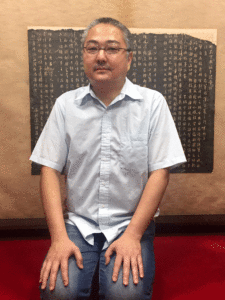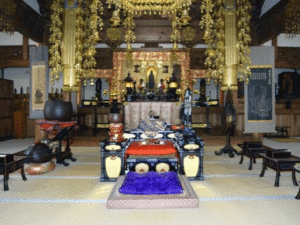Lada Vishtak is a cultural consultant working with Book-It on details in our adaptation of A Tale for the Time Being. She was in Japan this summer, and had a chance to speak with the Buddhist monk Seijun of Koushyoin, Jodo sect. He helped clarify various Buddhist practices in the story.

Lada Vishtak: How did you become a monk?
Seijun: Starting with my great-grandfather, we have been running this temple. Before the Meiji era, monks could not marry, but then things became more open, so the role of the monk usually got passed down to the next generation of that temple. In my case, I was a chemistry teacher until I was handed down the role of monk from my father.
LV: What do you do when you have time off?
S: On my time off, I just do what most others do (laughs)
LV: Like karaoke?
S: Sure, some of us enjoy it.
LV: What is a typical day for you?
S: I wake up early, clean the temple, read the sutras, eat breakfast, then sutras again at noon. In the afternoon, I conduct various rites at the temple or at other venues, study-sessions at large temples, and listen to and advise people who are struggling in life.
LV: Is it always the same sutras?
S: Yes, from my daily prayer book, in order. The first part of it is about purifying myself before addressing Buddha, then I chant one of the most important sutras, bupposo, which is basically saying, I will follow these three important rules (sanpou, which means, the three treasures): 1. Butsu: revere the enlightened ones, look towards the Light, lead a life full of positivity. 2. Hou: to take care of the words and values of Buddha, and lead a proper life. 3. Sou: get along with the Buddhist community and live harmoniously.
LV: Why is it important for human beings to have a spiritual life?
S: In Buddhism, you cannot be materialistic, or covet other people’s things, even in your mind. This is why monks only have the minimum amount of things. For example, in Indian Buddhism, they only have a cloth to sit and lie on (zagu), their clothes, and their kesa.
To become closer to Buddha is to clear away such materialistic and envious thoughts. If you have desires, and you can’t get them, then you have your struggles. The spiritual life is important because without it, you cannot reach enlightenment. More material desires lead to more strife and struggles within yourself. Humans cannot be Buddhas because we have to eat, and that’s where Amida-sama comes in as a savior. If we chant our namuamidabutsu (prayer), we can be close to the Light. As humans in this life, we cannot be Buddhas but through training and prayers, we can be in Amida-sama’s realm and can be that much closer to becoming a Buddha. Reincarnation has six levels, so only through prayers to Amida can we escape this cycle, which is one of perpetual struggle and suffering. Amida decides whether you can leave the cycle and your spiritual self will move on to be with Buddha.

LV: What does a monk wear?
S: It can differ slightly from sect to sect, but typically, a monk wears a white Japanese kimono called hakue as an undergarment. Over that, he wears a Chinese robe called jikitotsu. Then, over the jikitosu, he puts on the Indian kesa. The kesa was all that was worn by Indian monks, but it’s colder in China so they modified the dress. Furthermore, in Japan, an under-kimono was added, and so we can depict the flow of Buddhism from India to China and then to Japan with what we wear on our bodies. The kesa is one piece of cloth and it is worn with the right side exposed because that is the pure side or the hand of Buddha. Gasho, is putting your hands together in prayer, and it is important to not leave a space between the two hands. This is because gasho pose expresses unity between us and Buddha.
LV: What would a monk wear on his deathbed?
S: A monk would probably wear his hakue.
LV: And do all monks write a poem on their deathbed?
S: In Japan, they probably would.
LV: Can you tell us what might happen after their last poem?
S: If there are other monks nearby, they will chant prayers quietly. They will chant prayers so that they will be received by Buddha. Raihai bows (the highest bows to Buddha) may be done upon the death of a monk. The head is touching the ground and the palms are turned up to receive Buddha. The monk’s head would be pointing North and his face West, towards the land of Buddha. It is the nehan position of enlightenment; Oshakasama passed away in this position.
LV: Characters in the play deal with suicide and suicidal thoughts. What is the Buddhist belief on suicide?
S: Fundamentally, we do not believe in suicide. It is also written that we should not intentionally harm ourselves.